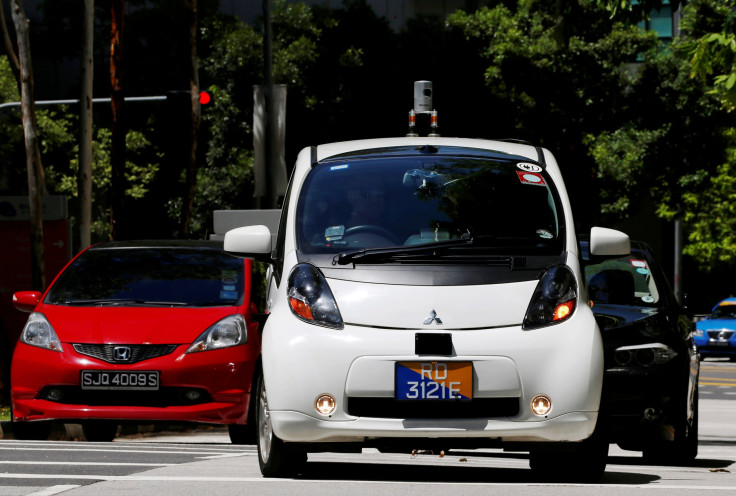Self-Driving: Tesla, Uber, Lyft And Others Building Own Vehicle Fleets

Self-driving cars might not be seen on the roads yet, but behind the scenes, they are actually progressing at warp speed. The technology has attracted not just the likes of ride-sharing companies such as Uber and Lyft, but even automotive companies such as General Motors (GM) and Ford and tech companies such as Apple and Nvidia.
One of the veterans of self-driving, Tesla, is now aiming for a new venture — its own fleet of self-driven electric semi-trucks, according to Reuters. It is developing technology which will allow transport trucks, i.e., Tesla’s electric semi-trucks to move around in a convoy formation and follow a lead vehicle which will provide them guidance.
Trending: Malia Obama, Former First Daughter, Spotted Enjoying Time With New ‘Mystery Guy’
According to the report, the company is meeting the California Department of Motor Vehicles (DMV) for getting clearance for testing its truck fleets.
Tesla is not the only company working on autonomous trucks. Uber-owned Otto has already showcased the technology while Google-owned Waymo has revealed that it is in the early stages of developing driverless truck technology.
What’s different though is the fact that the company has specifically asked the Nevada DMV that it wants to operate its trucks in ‘continuous manner’ which essentially means that it wants self-driven trucks to move around in a convoy formation.
But why a convoy formation? Tesla has not talked about it yet. But we can make some educated guesses, which only leads us to two possibilities — either the company is getting into the transportation business or its plans to market its trucks to large-scale transporters, who would transport a lot of products from one destination to another. We don’t know the answer yet, but the latter seems to be a more plausible explanation.
The prospect of targeting large-scale logistics using convoys of trucks is certainly better than offering individual trucks. This difference in approach towards self-driving can essentially differentiate Tesla from its rivals and provide it an advantage in terms of selling its self-driven trucks.
Whether the lead truck will be human driven or fully autonomous is not yet known. But, the stage at which the technology is at currently, a human driven truck might be an ideal option for transporters, who will have direct supervision over their fleet.
Uber has been also testing its self-driving car fleets, aimed at ride-sharing while its rival Lyft has partnered with GM to create its own fleet.
“If you assume the cost of these autonomous vehicles, the very early ones, will be six figures, there aren’t very many retail customers that are willing to go out and spend that kind of money. But even at that sort of cost, with a ride-sharing platform, you can build a business,” GM’s vice-president for strategy, Mike Abelson, had told Reuters about the venture in a November interview.
While the technology is yet to hit the roads, financial models around self-driven vehicles have already started to emerge. Self-driven cars are expected to disrupt the existing vehicle ownership and driving patterns. Since these vehicles will not need a human at the wheel, they can be expected to go longer distances at a go, stopping only to charge, which could revolutionize the trucking industry by introducing non-stop trucking.
For this to become a reality, one thing needs to improve though — the range of self-driving on a single charge.
Popular Now: ‘Big Brother’ Season 19: Jessica Jeopardizes Her Safety By Calling Josh ‘Fat’?
Venkat Vishwanathan, assistant professor of mechanical engineering at Carnegie Mellon University, told Reuters on Wednesday that commerical deployment of self-driving trucks won't be feasible until the driving range on the current batteries is improved. Currently, diesel trucks can travel up to 500 miles on a single tank while electric trucks travel just about 80 miles on a charge.
The technology needs to improve without expanding the size of the battery on the vehicles since a larger battery would essentially become the cargo, according to Vishwanathan.
For ride-hailing though, the prospects are better since the cars generally cover short distances. A number of such cars are already promising more than 200 miles on a single charge. Self -driven vehicles working around the clock would be able to ferry more passengers per day in comparison to existing vehicles. They would even save driver costs for the company, which is why companies such as Uber and Lyft are eager to invest in the technology.
Another thing the self-driving technology might change in the distant future is vehicle ownership itself. Since self-driven vehicles would be driven by automation, owners might be able to employ their self-driven cars in ferrying other people when they are not using them.
One thing is certain — self-driving is surely going change the concept of driving and the future of automotive industry once it hits the roads.
© Copyright IBTimes 2024. All rights reserved.





















